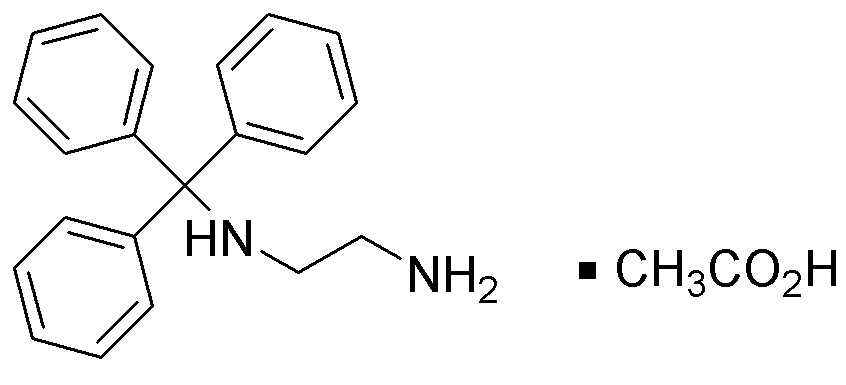Trityl-1,2-ethylenediamine acetic acid salt is widely utilized in research focused on:
- Pharmaceutical Development: This compound serves as a crucial intermediate in synthesizing various pharmaceuticals, enhancing drug efficacy and stability.
- Chemical Synthesis: It acts as a versatile reagent in organic synthesis, allowing researchers to create complex molecules with precision.
- Biochemical Research: The compound is employed in studies related to enzyme activity and protein interactions, providing insights into biological processes.
- Analytical Chemistry: It is used as a standard in chromatography, aiding in the accurate analysis of other compounds in complex mixtures.
- Material Science: This salt is explored in developing new materials, particularly in polymer chemistry, where it can enhance material properties.
Informations générales
Propriétés
Sécurité et réglementation
Applications
Trityl-1,2-ethylenediamine acetic acid salt is widely utilized in research focused on:
- Pharmaceutical Development: This compound serves as a crucial intermediate in synthesizing various pharmaceuticals, enhancing drug efficacy and stability.
- Chemical Synthesis: It acts as a versatile reagent in organic synthesis, allowing researchers to create complex molecules with precision.
- Biochemical Research: The compound is employed in studies related to enzyme activity and protein interactions, providing insights into biological processes.
- Analytical Chemistry: It is used as a standard in chromatography, aiding in the accurate analysis of other compounds in complex mixtures.
- Material Science: This salt is explored in developing new materials, particularly in polymer chemistry, where it can enhance material properties.
Documents
Fiches de données de sécurité (FDS)
La FDS fournit des informations de sécurité complètes sur la manipulation, le stockage et l’élimination du produit.
Spécifications du produit (PS)
Le PS fournit une description complète des propriétés du produit, notamment sa composition chimique, son état physique, sa pureté et les exigences de stockage. Il détaille également les plages de qualité acceptables et les applications prévues du produit.
Certificats d'analyse (COA)
Recherchez des certificats d'analyse (COA) en saisissant le numéro de lot du produit. Les numéros de lot et de lot se trouvent sur l'étiquette d'un produit, après les mots « Lot » ou « Lot de fabrication ».
Numéro de catalogue
Numéro de lot/série
Certificats d'origine (COO)
Ce certificat d'exploitation confirme le pays dans lequel le produit a été fabriqué, et détaille également les matériaux et composants utilisés et s'il est issu de sources naturelles, synthétiques ou autres sources spécifiques. Ce certificat peut être requis pour les douanes, le commerce et la conformité réglementaire.
Numéro de catalogue
Numéro de lot/série
Fiches de données de sécurité (FDS)
La FDS fournit des informations de sécurité complètes sur la manipulation, le stockage et l’élimination du produit.
DownloadSpécifications du produit (PS)
Le PS fournit une description complète des propriétés du produit, notamment sa composition chimique, son état physique, sa pureté et les exigences de stockage. Il détaille également les plages de qualité acceptables et les applications prévues du produit.
DownloadCertificats d'analyse (COA)
Recherchez des certificats d'analyse (COA) en saisissant le numéro de lot du produit. Les numéros de lot et de lot se trouvent sur l'étiquette d'un produit, après les mots « Lot » ou « Lot de fabrication ».
Numéro de catalogue
Numéro de lot/série
Certificats d'origine (COO)
Ce certificat d'exploitation confirme le pays dans lequel le produit a été fabriqué, et détaille également les matériaux et composants utilisés et s'il est issu de sources naturelles, synthétiques ou autres sources spécifiques. Ce certificat peut être requis pour les douanes, le commerce et la conformité réglementaire.


